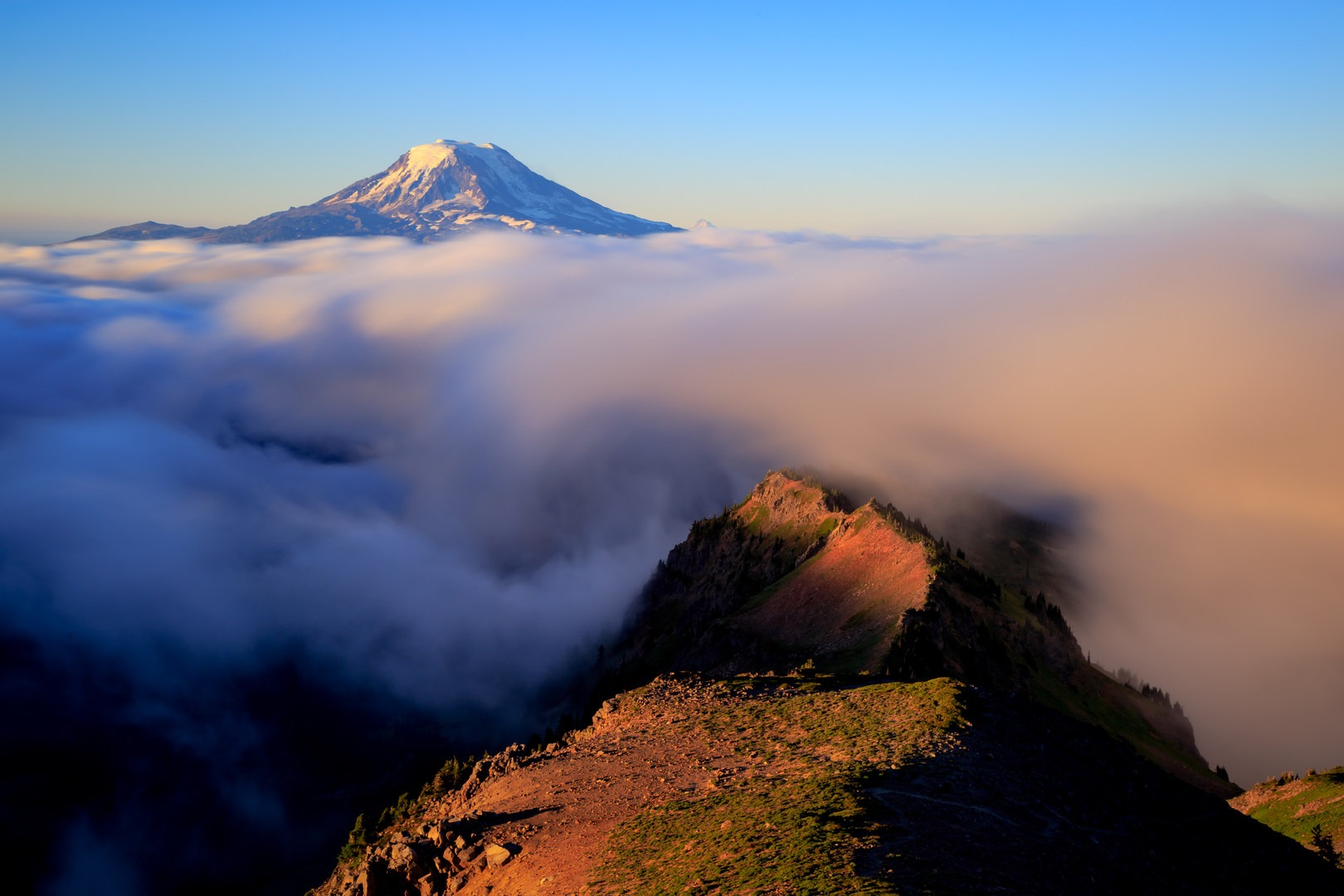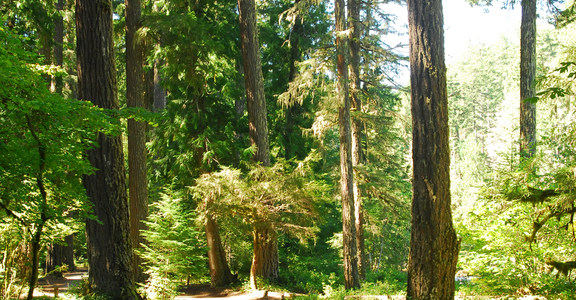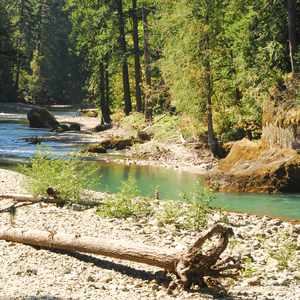You are here
A thru-hike in Washington's Goat Rocks Wilderness is a premier backcountry experience located smack in the middle of two massive, semi-dormant volcanoes and adjacent to a recently erupted one. These Goat Rocks are a collapsed/extinct ancient stratovolcano that has eroded into a series of alpine, glaciated peaks with lush, meadow-filled cirques and basins in their shadows. These expansive, sweeping, cascading, creek-strewn alpine meadows make up the majority of the terrain in this wilderness - an ideal stomping ground for mountain goats. Other wildlife frequenting the area include marmots, picas, deer, and elk. The best way to experience this playground of a wilderness is a thu-hike, camping in the most photogenic meadows and summiting its third-highest peak, just for fun! While it is possible to complete this itinerary in a much shorter timeframe, following it will ensure a fairly thorough exploration of the surrounding area and allow for plenty of chill-time in camp.
Day 1
Completing a somewhat arduous car shuttle is imperative for this itinerary. It is recommended to camp at Walupt Lake (the terminus) the night before your actual trip begins. Leave vehicle(s) here in an overnight parking area in the middle of the campground next to the vault toilet. Then drive the 29.4 miles to the northern Lilly Basin Trailhead. This drive can take approximately 1 hour and 30 minutes given that 90% of the route is on gravel roads. The Lilly Basin Trailhead has very limited parking. Only about four or five vehicles can fit safely in a roadside turnout here. It is marked by a solitary informational plaque. Leave the negative feelings of this excessive forest road driving behind as you jump onto a ridge-walk trail, gradually ascending through a classic Pacific Northwest forest of Douglas firs, western redcedars, and the like. This Lilly Basin Trail will eventually be followed to its end in Snowgrass Flat, approximately 12 miles to the southeast.
After approximately 3 miles on the Lilly Basin Trail, views start to become available of Packwood Lake and its sole island to the north. Meadows start to become more abundant as the trail climbs gradually, dispersing the thick forest, allowing for views of the massive Mount Rainier, just 20 miles to the northwest. The trail then gradually descends, continuing on this ridge walk, as Johnson Peak looms above to the east. The wildflower meadows in this area are filled (seemingly predominantly) with goatsbeard (western pasqueflower) with magenta (Indian) paintbrush, Yakima birdbeak, and the other major players typically seen in an Pacific Northwestern alpine meadow. The trail then makes a right turn to the south, traversing a cirque known as Lilly Basin on the western slope of Johnson Peak, in the alpine, crossing meadows and washes that form the headwaters of Johnson Creek. Views above the treeline of the western foothills are quite magnificent. Graduallly ascend through a talus scree field, along an obvious trail toward a pass on the southwest spur of Johnson Peak. A couple of switchbacks and a few well-formed tent platforms will be seen as the pass is obtained. This south end of Lilly Basin also serves as a junction with the marked Angry Mountain Trail.

A new view meets hikers after descending this pass and proceeding east toward a new cirque on the south slope of Johnson Peak. Descend, nearly back intro treeline, meeting a marked spur trail to Heart Lake (where several backcountry campsites will be found), then re-ascend into a vast, sloping meadow and new cirque. Views of the route ahead are obvious as the trail rounds the cirque to another pass with a prominent ridge nubbin named Hawkeye Point obvious above. Rounding the basin, take in the view of the very appropriately named Heart Lake on a bench at the bottom of this basin. The trail, again, gradually ascends via a few switchbacks surrounded by scattered scrub alpine trees before opening to another section of sloping, cascading meadow filled with tributaries and washes of snowmelt that eventually form the middle fork of Johnson Creek. Here, on a narrow bench, an ideal campsite will be found. Views of the western foothills and the enveloping cirque are quite appealing with running water easily accessible. As any hiker would expect to see when visiting this wilderness, herds of mountain goats frequent the alpine meadows. It has been about 8 miles and 2,500 vertical feet from the Lilly Basin Trailhead to this point.

Making a sunset/sunrise hike to Hawkeye Point is highly recommended. It is a short, albeit steep, 1.3 miles away from the previously mentioned campsite in Johnson Creek Meadow. Continue along the Lilly Basin Trail south through more scree fields, ascending to the obvious pass above on the southern horizon. The trail becomes sparse through here, but it may be marked by several cairns as it crosses multiple snowmelt tributaries and seasonal snowfields. Nearing the pass, a steep scree field may be difficult to cross if the trail has been recently washed away. Be sure to stop and enjoy the views of Mount Rainier behind you (to the north), now visible above Johnson Peak. This scree field is the final obstacle before reaching the Hawkeye Point spur trail pass and junction. This pass affords expansive, panoramic views of the previously obstructed Mount Adams to the south and the route ahead through the remaining Goat Rocks Wilderness. Continue northeast along the ridge as the spur trail climbs steeply and then drops down onto a saddle that may be occupied by a year-round snowfield before again climbing steeply through tundra-like terrain before topping out on the former lookout site known as Hawkeye Point. Nearly 1,000 vertical feet have been accomplished from the Johnson Creek campsite. There are obvious ruins of the former lookout here, but your eye will likely be drawn to the unimpeded, 360-degree view of the surrounding peaks and distant volcanoes. Mount Rainier to the north and Mount Adams to the south with Mount St. Helens in the distance to the west. If the visibility is good enough, you may even spot Mount Hood partially obstructed by the western slope of Mount Adams. Also, spot Goat Lake below a sheer cliff on the southeast slope of this aptly named point. You may find this little jaunt worth the effort after returning to camp in the Johnson Creek Meadow.
Day 2
From the Johnson Creek camp, return to the Hawkeye Point spur trail pass/junction and then descend on the south side of the spur, noting several tent platforms here. Running water may be available as seasonal snowmelt forms the headwaters of Jordan Creek. After passing the Goat Ridge Trail junction, the trail ceases its descent and levels out as it, again, traces another basin/cirque. This new basin is substantial in size, but it is similar to the two previously encountered ones with open, sloping meadows. Bordered by Goat Ridge to the west and the high Old Snowy Mountain with the adjacent Ives Peak to the east, the resulting expansive canyon is quite photogenic. After a little more than 1 mile from the Hawkeye Point spur trial junction, arrive at Goat Lake. Hawkeye Point sits above the lake's northeast sheer slope. This scenic, popular wilderness destination, complete with floating icebergs, is also a heavily used camping area. Several shore campsites and nearby southern ridge sites can be found. The uncontrolled usage of this lake has caused a somewhat trampled terrain.

However, the recommended camping area for night two on this trip lies an additional 3.25 miles south in the sought after Snowgrass Flat area. The trail ever so gradually descends from Goat Lake south, delving back into sparse scrub alpine forest, passing an immense number of trailside campsites, a couple of tributaries, and a spring. The terrain continues to remain interesting, traveling along treeline that is interrupted by periodic meadows. Approach the Snowgrass Flat cutoff trail junction, ascending to the east via a couple switchbacks toward the Pacific Crest Trail - the junction is marked by a very large cairn and trail sign. There are several appealing campsites near the treeline along the PCT. Running water can be found at the Snowgrass Creek spring just south of the Snowgrass Flat Trail/PCT junction. It has only been about 6 miles since leaving Johnson Creek Meadow, but so many views have been taken in. You may also find the additional rest time welcome prior to attempting a summit of Old Snowy Mountain the next morning.
Day 3
Camping in the PCT meadow above Snowgrass Flat allows for an ideal day hike summit trip to Old Snowy Mountain before proceeding to the next campsite. Leave your overnight gear in camp and take the PCT north paralleling yesterday's route south, far below the western ridge. The busy PCT switches back, gradually climbing through expansive meadows, leaving the trees behind, affording views of Mount Adams to the south and Mount St. Helens in the distant west. As you climb, the meadows are left behind as well, replaced with rocky talus. Note views of the Goat Lake Basin to the near northwest. Then, approaching the dropped-off ridge above Packwood Glacier, in-your-face views of Mount Rainier to the north become unavoidable. Proceed east to the PCT/Old Snowy Mountain summit trail/PCT alternate trail junction. The designated PCT continues above Packwood Glacier along this ridge. However, an alternate PCT route provides intrepid thru-hikers with an opportunity to summit Old Snowy without a significant detour. This marked detour climbs southeast over densely packed rock, switching back to another junction with Old Snowy's summit route proper. Continue along the obvious south ridge of Old Snowy as it now climbs quite steeply through dense igneous talus and boulders. Nearing the summit, some hands-on travel may be necessary, taking a short scramble atop a few large boulders. This view from the 7,858-foot summit of Old Snowy Mountain is unparalleled. Take in the entire Goat Rocks Wilderness, including its high point, Gilbert Peak at 8,184 to the southeast on the Yakima Reservation. Ives Peak, slightly shorter, lies adjacent to the immediate south and Goat Lake to the near northwest. However, the massive volcanoes continue to steal the show: Mount Adams to the south, Mount St. Helens to the west, and Mount Rainier to the north. A very similar view to the visible Hawkeye Point.

Retrace your route down the summit trail, perhaps walking a few steps along the PCT alternate route to the north of the high junction just to view the knife edge trail - the highest point of the PCT in Washington at 7,592 feet. Otherwise, continue along the PCT alternate west back to the main PCT and down to the high Snowgrass Flat meadow, returning to camp. This summit jaunt day hike totals approximately 5 miles and 1,600 feet of elevation gain. Don't worry, you only have to do another 2.5 miles with only 200 feet of gain before finding your next campsite. Pack up camp, and then take the PCT south as it descends back into thick forest leaving views of Old Snowy and Ives Peak and their western meadows behind. Meet the southern Snowgrass Flat cutoff trail junction after a little more than half a mile down a few switchbacks. Continue on the PCT as it turns east. After approximately another mile, without much warning, the forest gives way to dramatic views of another sloping, cascading, expansive meadow occupying Cispus Basin. A few sites can be found perched in the giving way treeline here. Heavy snowmelt creeks tumble down this steep basin's slopes, echoing off the encompassing walls. Cross the south slope's meadow (now below Ives Peak), successively crossing an unnamed creek at the base of a beautiful, fanned 40-foot waterfall. Nearing the eastern bowl of this new basin, a few exclusive campsites will be spotted among a small group of trees on the right of this photo along the major Cispus Creek. A rugged rampart of a cliff face forming the northwest spur of the obstructed Gilbert Peak sits above the eastern slope providing an ideal backdrop for photos.

Day 4
From Cispus Basin, it's a fairly straightforward route back to your terminus of Walupt Lake. Proceed on the PCT as it ascends out of Cispus Basin, rounding a spur through a sparse meadow, gradually climbing to the forested Cispus Pass after about 0.5 miles. Enjoy views here back to the north of Ives Peak above Cispus Basin and the now unobstructed cliff band to the east as it forms the base of Gilbert Peak. Continue south on the PCT, now serving as a border between Gifford Pinchot National Forest and the Yakima Reservation. The route, for the final time, descends back into thick forest, intermittently spotted with sweeping meadows allowing for periodic views of the western foothills. After another 2.25 miles on the PCT south of Cispus Pass, meet the signed Nannie Ridge Trail junction marked by Sheep Lake. More campsites are found here. Now on the Nannie Ridge Trail, proceed southeast above the lake where goodbye views of the high Goat Rocks peaks behind you should be enjoyed. Continue on this ridge walk as it gradually descends, then ascends for a short time through forest. Be sure to take in final views of Mount Adams to the south as they become avialable intermittently through gaps in the trees. Round the south side of the high point of the ridge before descending steeply via a series of seemingly unending switchbacks, into old-growth forest as the trail finally levels out on the approach to Walupt Lake. Now, obviously, the last thing you will want to do at this time is return along the gravel forest roads, the 90-minute drive to the northern Lilly Basin Trailhead to pick up the previously parked vehicles. But use this time to reflect on the incredible alpine wilderness you just experienced.
Logistics + Planning
Current Weather: Powered by Dark Sky





























Comments
Sign In and share them.